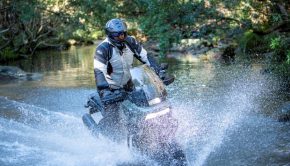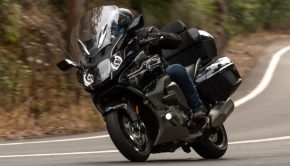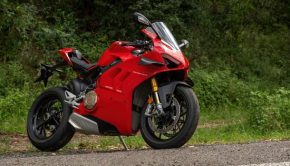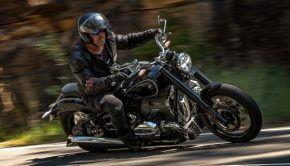YAMAHA FJR-1300A: VELVET GLOVE, IRON FIST
I picked up the Yamaha FJR1300A three days before Borrie’s Annual Xmas Road Party, an affair which works motorcycles hard. My orientation consisted of riding the bike home, and taking it out for a two hour spin the next day.
The FJR1300A is big. It’s long, heavy and tall. It pushes its front wheel in real slow turns like roundabouts, and you need to give it a bit of throttle to stand it back up again. But I guess it wasn’t built for slow turns like roundabouts.
It weighs, so I’m told, 264kg dry. The weight and width reduce lane splitting opportunities, but the power is great for getting away from traffic lights and for overtaking. It’s dead smooth, and pulls like a train from 2000 rpm. They’ve upped the gearing for the 2006 model, and at 60km/h it’s pulling less than 2000 rpm. It will accelerate from those revs, and accelerate hard, but it’s a little rough. I used 4th as my top gear for 60 zones.

The Multi Function Display
It’s got a multi function display that incorporates a fuel gauge, coolant temperature gauge, odometer, two trip meters, gear position indicator, clock, ambient temperature gauge and fuel consumption information (instantaneous and average). The clock helps in school speed zones.
The screen on the fairing is vertically adjustable. You press a rocker switch on the left handlebar, and the screen goes up 13 centimetres. It’s great for amusing kids at traffic lights.
It’s also 2.5 cm more than it moved on the last model, 5 cm closer to the rider, and has air ducts to stop you getting pushed in the back as the turbulence hits the low pressure area.
To help with parking in tight spaces, the mirrors fold forward AND backward. Which is kind of useful in my garage.
The next day, I took it up the F3 expressway north of Sydney a bit, and through some back roads on the Central Coast. On first hitting expressway speeds, my upper body was taking a bit of a buffeting — fixed by pressing the fairing button on the left handgrip for a few seconds. Excellent!
You can set the multi function display to display fuel consumption in km/l or l/100km. I set it to km/l. I know it’s the official Australian method, but I don’t do litres/100km. What a stupid way to measure fuel consumption. I’m glad they shot whoever thought of that before she came up with hrs/100km as a measure of speed. If you don’t agree, do your own math.
Riding easy, with the screen up, at the posted speed limits of 100 to 110 km/hr, the FJR gets about 21 to 22 km/l. It’s a 25 litre tank, so a quiet and legal tourer can probably go 500km on a tank. Maybe more with the screen down. But riding easy at legal speeds is amazingly hard to do on this motorcycle. There are two reasons for this.

Shields up! The FJR1300A’s protection against Klingon death rays is excellent.
The first is that this much power and this motorcycle’s delivery of it is just so much damned FUN. On the expressway, you can be at 100km/h heading up a steep hill, and be gaining on a slow vehicle. You change lanes, open the throttle, and the thing goes WHOOSH and you’re going 160km/h in four or five seconds. Up hill. Top gear. FUN.
The second is that I found the throttle return spring to be quite stiff. Holding any legal cruising speed in the land means that the throttle is just a fraction off the stop, and holding it so precisely against that spring made my wrist ache after half an hour or so. On twisty roads or in traffic it’s fine because you’re moving the throttle as you accelerate and brake, but holding it just cracked open and steady gave me cramps.
In a quick burn over some back roads, the suspension and tyres worked well for me, so I didn’t bother to adjust anything. The fork springs on the 2006 model are stiffer than before, but an improved fork bushing cuts static friction and maintains ride suppleness. The test machine had standard rubber on it: a pair of Metzeler Roadtecs, 120/70 x 17 front and 180/55x 17 rear. Nothing wrong with them.
And then I was ready to pack for Borrie’s Annual Xmas Road Party.
The luggage system is great. Turn a key, lift the panniers off, and they’re oddly shaped suitcases. I filled them with 15 kilos of stuff I didn’t need for a two day run. Like a change of clothes and shoes for dinner. Just because I could.
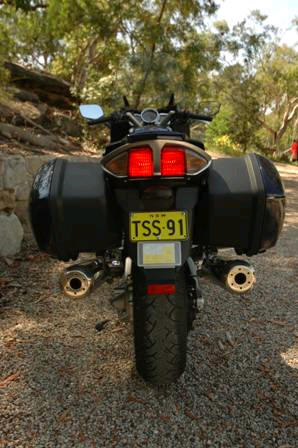
Al didn’t lane-split, but he packed enough to be the best dressed guy in Tamworth
There’s an optional top box, which was not fitted to the test bike. There is a lock for it in a plastic bag under the seat to make sure your luggage opens with YOUR key. There is a small rack on which the top box mounts, and it has generous grab rails on the side for the passenger.
There are also two under seat storage compartments, and a kind of mini glove compartment. It’s to the left, in the fairing, and I couldn’t fit my gloves in it. For this reason, I guess, Yamaha call it the “Accessory Box”. It will only open when the ignition is on. There’s a warning not to put heat sensitive things in it. And there’s a DC Accessory Jack (cigarette lighter plug) inside it. The manual warns you not to use it with the engine turned off. I guess you could use it to charge your phone while riding. Or for hunting pigs with spotlights. Or something.
There is a pair of knobs to adjust the headlight vertically in case your load has changed the vehicle’s attitude.
Riding the M2 expressway on the way to the Putty Road gave me time to experiment with the screen. It’s definitely better up. It was a hot day, and I found I was very comfortable with my jacket open behind the screen. And my comfort matters. It’s all about me.
The run started at 7:00am. There were some hard riding men and women in the group. I only went eight tenths, though. I didn’t want to bend Yamaha’s motorcycle, and there was the occasional dead ?roo on the side of the road to remind me what others had hit. That huge acceleration, however, helped me to stay not too far behind the fast guys.
The FJ1300A steers well. It’s got over a metre and a half of wheelbase, and a chassis made out of large stiff bits of metal. Its forks are 48mm jobs. It handles bumps midway through 180km/h sweepers without wallowing, unless you back off the throttle hard halfway through and make the back dump. Otherwise, it keeps tracking straight.
I hadn’t ridden a shaft drive for a while, and it takes a little while to get used to how they behave. Shaft drives rise at the back under acceleration as the pinion tries to climb the ring gear, and they do the reverse on overrun. This causes you to lose ground clearance, so it’s best avoided during hero antics in turns. They have more unsprung weight than chain drive motorcycles, so you’re more likely to lock up on washboard surfaces coming into slow corners. And they have less drivetrain play, making the transmission feel a bit notchy unless you time each shift perfectly.
I was OK for ground clearance. I didn’t touch any part of the motorcycle to the ground, but I put a nice chamfer on both my boots. I never noticed the back break traction under brakes, either. Probably because the “A” in FJR1300A stands for ABS.
The FJR1300A’s brakes are fantastic. The big 320mm front disks spin inside four piston calipers. There’s a “Unified Braking System”. The brake pedal operates the rear two pistons in the right front caliper as well as the rear brake – a two piston caliper on a 280mm disk. The brake lever operates the remaining six pistons in the front system.
I’ve heard arguments about people getting used to this system. I didn’t have any transition problems at all. I just got on a motorcycle that stopped extremely well and didn’t even find out about the feature until I read about it.
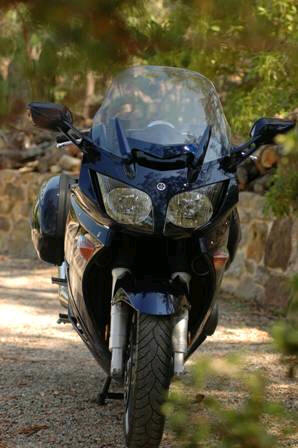
The front: Metzeler Roadtec, 48mm forks adjustable for preload, compression and rebound damping; eight pads squeezing two 320mm disks, ABS, folding mirrors, electric windscreen, adjustable headlights
And I was OK for performance. The motor reputedly makes 105.7kw (145bhp) at 8500rpm. At 4500rpm it’s doing 140km/hr, so if it will pull 8500 in top it should peak out at about 265km/h. At 200, the throttle isn’t against the stop. It feels like it has another easy forty or fifty in it. I felt like I didn’t have enough road to see if it had another forty or fifty in it, so I backed off.
You pay for the exuberance, though. Ridden like this, the fuel consumption is around 16.4km/l, cutting the theoretical range down to about 400km.
That’s about as far as most people go without stopping anyway. The seat is a good compromise, but sitting on ANYTHING for three or four hours straight makes me want to do something else for a while. It’s comfortable to sit on but firm enough to move around on in corners when you’re in sport mode. The height of the seat suited me fine. If it doesn’t suit you, there is a three position adjustment. It was on the lowest.
Just about everything on this motorcycle is adjustable.
The handlebars are three way adjustable. How, exactly, is not revealed. There’s a cover over the workings, and a note in the owner’s manual to have your Yamaha dealer do it.
The fairing cowlings can be opened 3cm to allow more air through. There are quarter-turn screws involved, so you need a screwdriver or something. You could probably do the job in two minutes with a five cent piece to undo the quarter-turn screws.
The front suspension is adjustable for preload (need spanner), rebound damping (knob, can use fingers) and compression damping (need screwdriver). Each fork must be adjusted separately, and, of course, identically.
The rear nitrogen shock is fitted with an easy-to-get-at two position preload adjustment lever (solo and passenger). It also has a rebound damping knob that you can change without tools.
I felt like a bit of a piker for leaving everything standard. The motorcycle worked well, though, for the fast run to the Putty Road Half Way House, and even in the tighter stuff after that.

It didn’t mind the Ten Mile at all…
It didn’t mind the Ten Mile at all. For non-NSW dwellers, the sixteen kilometres where the Putty Road follows Darkey Creek is all short straights ending in turns posted at 35-55km/h, and it’s well paved. The big Yamaha likes to have you decide a line, commit, and let it do its stuff. If you do that, it sails around like some huge ship trailing the outside of your boot on the tarmac and it feels sooo stable. If you stuff it up, you’ve got the problem of getting 400-odd kilos of bike and rider that’s 2.23 metres long pointing in another direction. It happens, you just have to work at it a bit.
Early after lunch on the first day of Borrie’s Annual Xmas Road Party, a hot wind came up from the south. I was riding along watching the trees bend and feeling the gusts on my jacket. The bike didn’t move about at all – it just kept headed where it was pointed.
The first day’s ride finished at an ambient temperature of 40 degrees, according to the Multi Function Display. I was pretty comfortable in a leather jacket half zipped sitting behind the FJR1300A’s screen. Yamaha have managed the airflow in such a way that hot engine air almost never hits the rider. I have to admit, though, that sitting in the motel pool half an hour later with a cold beer was pretty comfortable.
The next day’s ride was the Oxley Highway to Port Macquarie, which I’d never ridden before. What a fantastic road. It’s got everything – straights, sweepers, tight bits and scenery. The FJR1300A scored another plus in the stability stakes. Over wooden bridges, it doesn’t shake its head and try to track along the gaps between the planks. It just goes in the direction it’s pointing.
And it handles the tight stuff well. Heading east past Ginger’s Creek the Oxley gets REAL tight, with corners posted as low as 25 km/h. The FJR1300A dealt with them just fine. For its weight, it does very well indeed.

Bikecam video grab – the FJR1300A at speed on Borrie’s Annual Xmas Road Party
I left Borrie’s Annual Xmas Road Party after the Oxley Highway. I fuelled up at Kew and re-set the fuel consumption computer. I headed down the highway nice and slow all by myself. The FJR1300A was sipping fuel at 22km/l. I was bored stupid. And my right wrist began to ache.
However, for the first time I noticed some vibration. It’s at about 120 km/h. It’s not uncomfortable and in fact barely perceptible through bars and footrests, but the right side mirror goes slightly blurry. The left side doesn’t.
I cranked it up a bit. I finished my trip home at a fast but wary clip, never exceeding 140km/h. With this sort of riding, the FJR1300A drinks at about 19km/l, giving a range of around 450 kilometres.
Four hours later, I was home in Sydney. I’d ridden a bit over 1,000 kilometres on the FJR1300A. Fast and slow, sports and touring, twisty and straight.
I even had a brief stint as a pillion passenger on it. The pillion seat is comfortable, and there is plenty of grab rail to hang on to. Yamaha say they’ve moved the pillion pegs forward 5cm this year to improve comfort. I didn’t ride the previous model, but the pillion seating position suited me as well as everything else on this motorcycle did.
I didn’t adjust the shock preload before the brief two-up ride. It touched its centrestand and hero knobs to the tar twice in that run when it hit bumps at cornering speeds which made me glad I couldn’t see the speedo.
The best things about this motorcycle are that it eats miles, it’s fast, it steers well, and it’s comfortable. It’s safe, with antilock brakes, good handling and plenty of acceleration to get you out of trouble. It has a great luggage system standard, and some nice luxuries. And the airstream management is excellent.
The worst thing for me was the throttle return spring. Maybe you just develop muscles and get used to it. I wasn’t with the bike that long.

…a great mile-eating sports tourer that’s bad at nothing
But apart from that, there wasn’t a thing I didn’t like about the bike. For $22,199 plus on road costs I’d expect a self cancelling indicator switch, but that’s just me being picky.
Overall, it’s a great mile-eating sports tourer that’s bad at nothing. You can travel a lot of miles in a short amount of time on it and have a lot of fun on the way; with occasional touches of luxury like your mobile phone charging in the accessories box and a fairing screen you can change without getting off. You won’t disgrace yourself having a scratch on the Bell’s Line of Road or the Putty with your friends, but your girl will still enjoy a ride in comfort when you decide on a weekend away. And you can play with all of the adjustments and get it just right for YOU.
There are plenty of people to whom that scenario appeals. Yamaha has just the machine for them.
FJR 1300 Specs
| ENGINE/IGNITION/TRANSMISSION | |
|---|---|
| Type | In-line 4-cylinder engine, 16 valves, DOHC |
| Displacement - (cc) | 1298 |
| Bore Stroke - (mm) | 79 x 66.2 |
| Compression | 10.8:1 |
| Lubrication | Wet sump |
| Fuel Management | Electronic fuel injection |
| Ignition | TCI |
| Starter | Electric |
| Fueltank - (L) | 25 |
| Oil Capacity - (L) | 4.9 |
| Transmission | Constant mesh, 5 speed |
| Final Transmission | Shaft |
| CHASSIS | |
| Length - (mm) | 2230 |
| Width - (mm) | 750 |
| Height - (mm) | 1450 |
| Seat Height - (mm) | 800 |
| Wheelbase - (mm) | 1545 |
| Clearance - (mm) | 130 |
| Dry Weight - (kg) | 264 |
| FRONT END | |
| Suspension Front | Telescopic fork,Ê48mm |
| Tyres Front | 120/70 ZR17M/C (58W) |
| Brakes Front | Dual discs,Ê320mm |
| REAR END | |
| Suspension Rear | Swingarm (Link-type) |
| Tyres Rear | 180/55 ZR17M/C (73W) |
| Brakes Rear | Single disc,Ê282mm |


